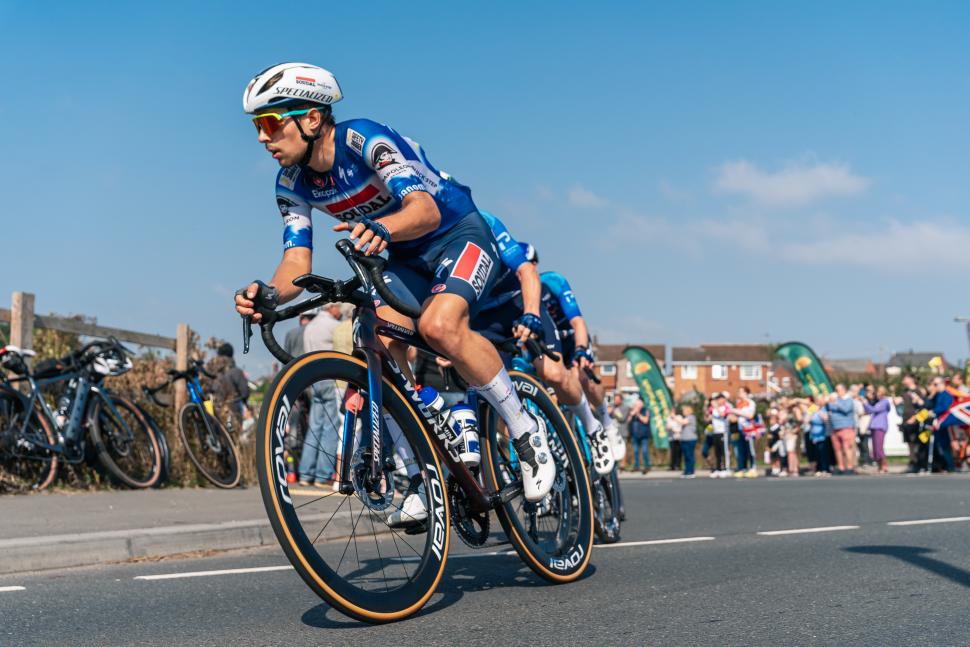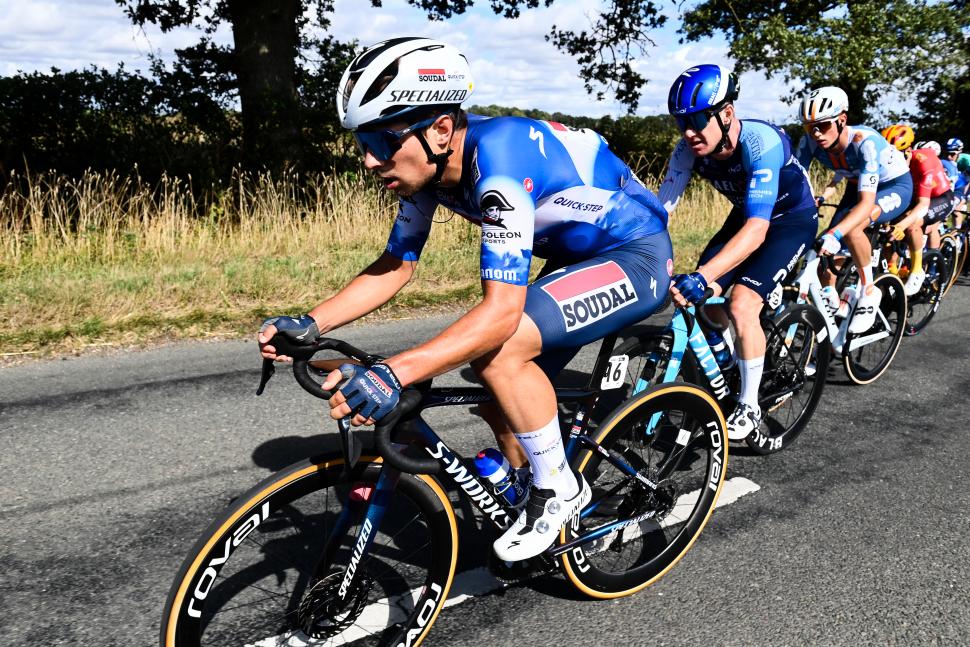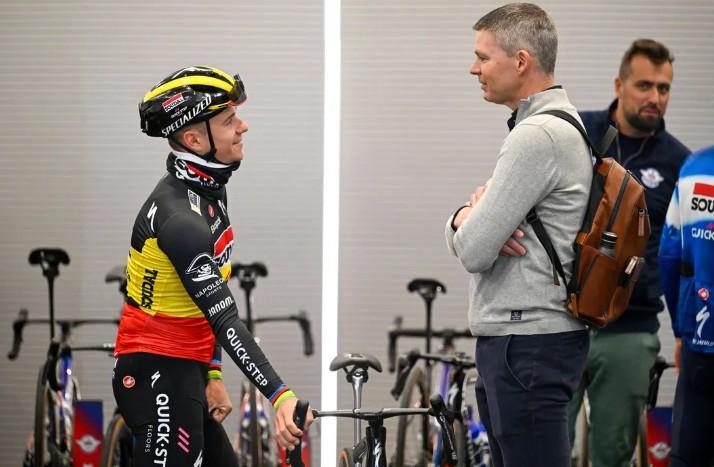- News
- Reviews
- Bikes
- Components
- Bar tape & grips
- Bottom brackets
- Brake & gear cables
- Brake & STI levers
- Brake pads & spares
- Brakes
- Cassettes & freewheels
- Chains
- Chainsets & chainrings
- Derailleurs - front
- Derailleurs - rear
- Forks
- Gear levers & shifters
- Groupsets
- Handlebars & extensions
- Headsets
- Hubs
- Inner tubes
- Pedals
- Quick releases & skewers
- Saddles
- Seatposts
- Stems
- Wheels
- Tyres
- Tubeless valves
- Accessories
- Accessories - misc
- Computer mounts
- Bags
- Bar ends
- Bike bags & cases
- Bottle cages
- Bottles
- Cameras
- Car racks
- Child seats
- Computers
- Glasses
- GPS units
- Helmets
- Lights - front
- Lights - rear
- Lights - sets
- Locks
- Mirrors
- Mudguards
- Racks
- Pumps & CO2 inflators
- Puncture kits
- Reflectives
- Smart watches
- Stands and racks
- Trailers
- Clothing
- Health, fitness and nutrition
- Tools and workshop
- Miscellaneous
- Buyers Guides
- Features
- Forum
- Recommends
- Podcast
news
 Martin Svrček, 2024 Tour of Britain (credit: Elliot Keen/British Cycling/via SWpix.com)
Martin Svrček, 2024 Tour of Britain (credit: Elliot Keen/British Cycling/via SWpix.com)Pro cyclist’s horror three-metre plunge over guardrail sparks call for more earpieces, gear limits, protective kit, and other safety measures
A horror crash at Milan-Samremo, which saw Martin Svrček plunge unnoticed three metres over a guardrail, has prompted the rider’s Soudal Quick-Step boss to call for increased safety measures at races, including gear restrictions and improved helmets, as well opposing any plans to limit communication between teams and riders.
22-year-old Slovakian pro Svrček, who finished third in the U23 road race at the 2023 world championships in Glasgow, crashed on the descent of the Cipressa towards the end of the opening monument of the season on Saturday, flying over a guardrail and falling three metres before landing.
As he was alone at the time, chasing back to the peloton, the Slovakian’s crash went completely unnoticed by the race convoy. Fortunately, Svrček remained conscious enough to contact his Soudal Quick-Step directors for help through his race radio. They were then able to stop their car and walk 500 metres back up the road, where they found the 22-year-old and treated him for his injuries.
Svrček suffered a fractured collarbone, scapula, and ribs in the shocking crash, which he described on Instagram this week as a “hard moment”, writing that he “will now have to take some time to recover”.
Following the crash, Svrček’s Soudal Quick-Step boss Jurgen Foré has this week penned an open letter calling for more robust safety measures to prevent similar incidents happening in the future, arguing that “we can’t ignore this”.
“Because Martin is a young, talented, but not yet well-known rider in our team, the message does not get much attention. But it should. We read that kind of message too often,” Foré, who took over as CEO of the Belgian team from longstanding figurehead Patrick Lefevere in December, a year earlier than originally planned, said in his letter, Sporza reports.
“I don’t want to point the finger at the race organisation. It was a crash that was caused by several factors. But I can’t remain silent either,” he continued.
“Martin crashed on the descent of the Cipressa when he was trying to join the peloton. In a technical bend he went over the guardrail and fell about three metres down. He was completely alone and there were no cars nearby that could have seen him.
“Luckily he was conscious and called for help on the team radio. Our team directors immediately stopped the car and walked back. After 500 metres they found him and were able to treat him.
“In the hospital he/we realised how lucky he/we were that Svrček would recover from the long list of injuries.
“I felt particularly small when I stood next to Martin’s bed in the emergency room in Sanremo. Okay, it’s a race incident, but we can’t ignore this and move on. We must do everything we can to prevent the serious consequences of these types of crashes, or better yet, avoid these crashes altogether.”
Foré then revealed that Soudal Quick-Step have now established their own “internal safety group” in the wake of the injuries sustained in recent months by Svrček, Antoine Huby, and double Olympic champion Remco Evenepoel, who has missed the start of the season after suffering multiple fractures in a ‘dooring’ incident on a training ride in December.
“We have to do better to avoid such accidents in the future. Three months into the 2025 season, our team has three riders who will be out for months. That is why we are bringing together a group of riders in an internal safety group,” he wrote.
“In that group, we will look at what we can do ourselves to improve safety in our team. That group can also be a sounding board for our bike, equipment, and clothing partners.”
> UCI considering use of “rider airbags” and gear restrictions to “enhance safety”
Looking beyond his own team, Foré suggested a range of measures which he believes should be implemented by the UCI, including the need to ensure that communication between the riders, teams, and organisers is available at all times.
While the use of earpieces in the peloton has been a constant source of debate over the past decade – with some arguing that the constant flurry of tactical information provided over radio by teams harms the spectacle, while increasing stress within the peloton – the need for effective communication, Foré says, has been underlined by Svrček’s crash at Sanremo.
“Let’s embrace technology,” the team boss argued. “For example, we can never again finish a race without communication with the riders. Earpieces are a crucial source of information for the riders, enabling them to call for help.
“They are an essential tool to provide our riders with safety information, but it is also crucial to give riders the opportunity to ask for help if they get into trouble. A tracking system would give the race organisation and the teams a tool to see in real time if a rider gets into a difficult situation and to send help immediately if necessary.
“It could also be useful to analyse racing incidents directly after the race and give the organisers feedback to make their race safer.”
Meanwhile, Foré also joined the growing number of voices calling for restrictions on the range of gears used by riders, in a bid to lower speeds and reduce the threat of serious, high-speed crashes.
That particular issue made headlines back in January, when Wout van Aert suggested that limiting the pro peloton’s gearing choices “would make cycling a lot safer”. The Belgian’s comments were backed by four-time Tour de France winner Chris Froome, who despite dismissing a return to junior gearing, argued “maybe 56 or 54 needs to be the limit”.
And this week, the Professional Cycling Council (PCC) confirmed that it had accepted a proposal to implement a gear ratio limitation trial later in the season, though this is currently pending approval by the UCI’s management committee.
The Soudal Quick-Step CEO, who says “all stakeholders must take their collective responsibility”, also called for stricter measures concerning the use of extremely narrow handlebars and the positions of shifters, while arguing for “better safety checks on the course, especially at dangerous points”.
He also said improved helmets and protective clothing should be introduced, starting in training and even at the expense of aerodynamics, and that race organisers should consider introducing more localised laps to “make it easier to guarantee optimal safety for the peloton”.
As noted by Foré, the issue of safety in the peloton has dominated debate in pro cycling circles over the past year, in the wake of a 2024 road season marred by horrendous high-speed crashes at Dwars door Vlaanderen and the Itzulia Basque Country a week later, and the tragic deaths of Swiss junior rider Muriel Furrer and Norwegian pro André Drege during races.
In January, the UCI revealed that is considering introducing a range of “equipment-related solutions”, including the use of rider airbags, gear restrictions to reduce top speeds, and clamping down on narrow handlebars, in a bid to “enhance safety” during races.
After obtaining a PhD, lecturing, and hosting a history podcast at Queen’s University Belfast, Ryan joined road.cc in December 2021 and since then has kept the site’s readers and listeners informed and enthralled (well at least occasionally) on news, the live blog, and the road.cc Podcast. After boarding a wrong bus at the world championships and ruining a good pair of jeans at the cyclocross, he now serves as road.cc’s senior news writer. Before his foray into cycling journalism, he wallowed in the equally pitiless world of academia, where he wrote a book about Victorian politics and droned on about cycling and bikes to classes of bored students (while taking every chance he could get to talk about cycling in print or on the radio). He can be found riding his bike very slowly around the narrow, scenic country lanes of Co. Down.
Latest Comments
- Secret_squirrel 1 hour 47 min ago
Um...no. Spitting is grim and there is never any excuse.
- Another_MAMIL 4 hours 43 min ago
Q36.5 Gregarius Essential Bib Knickers fit the bill: 3/4 length bib tights for warm weather.
- Rendel Harris 4 hours 54 min ago
Jolly good. Only it hasn't been and it is still a public bridleway. Feel free to look it up.
- jaymack 5 hours 44 min ago
"...it feels more like a £100+ jersey". It's almost as if cycling apparel is over priced.
- mike the bike 6 hours 56 min ago
I've had a few Lezyne bits and bobs over the years and while it's true I've never bothered to return anything under warranty, I've had a couple of...
- mark1a 5 hours 59 min ago
There's a transition period. For the benefit in kind (BIK) tax to the employee, it will be treated as a goods vehicle as it is now (rather than a...
- hawkinspeter 7 hours 8 min ago
Parents say East Bristol Liveable Neighbourhood makes roads '100 times safer' for children:...
- mdavidford 7 hours 14 min ago
Isn't basically all carbon recycled? From stars?
- velodinho 8 hours 30 min ago
As witnessed at so many infrastructure improvement projects similar to this one, all those who object should ignore the consultation and pray at...
- Nagai74 10 hours 18 min ago
It's a DLO to those in the trade.


Add new comment
15 comments
In recent years, it has all been about Aero gains, every new frame "saves 7 watts at 45kph"!
Instead of Aero frames, aero wheels, aero bars, perhaps the UCI should set a minimum Cd for a cycle.
The most refined aero bike is only going to be one or two km/h faster on the descents than a standard race bike, definitely not enough to make a difference to safety in any appreciable manner. Setting maximum gear ratios so that riders would spin out at lower speeds rather than being able to drive on towards three figures might have more effect.
I wonder if GCN have tested this?
They have here: results at 14.40. The aero bike was roughly fifteen seconds faster than a climbing bike on a descent of around 6 km, so about 3km/h faster.
I thought Pro riders were opposed to the ban on the supertuck, have they now reflected on this and now want speed limiters instead?
My Garmin 1030 thinks I've crashed if I just brake a bit sharpish coming up to traffic lights.
That would make an interesting cycle race.
I realised that the lads crash is a rare set of circumstances, and the numbers in the race would add complexity, but don't smart watches have impact sensors and GPS trackers built in? And maybe cycle computers?
Presumably they could also be tracked by their telemetry transponders, which have a signal strength strong enough to transmit power data et cetera to cars a considerable distance away.
Absolutely this, riders gonna crash it is a race. And tempering any aspect of that competitiveness would detract from the race but developing tansponder capabiltiy to ensure that riders are always tracked within the "virtual net" of the race and can be accounted for is a relatively simple ask with modern tech eg apple air tag or as others have already mentioned Garmin, or See.Sense smart lights with crash sensors etc.
Might need a slight merge in tech but set a corridor for the route and when a tag moves outside the corridor then alarm. When the tag becomes stationary it can flag, might just be a mechancial but it can be accepted once the incident is found.
All teams cars can see their own riders and all safety vehicles can see all riders with the broom wagon actually going back to it's true purpose ensuring all riders are accounted for before the race can be considered to have passed safely.
The front of the race will be as fast as the riders determine, the back of the race is not merely chasing the front but riding at the pace that assures rider health.
My Garmin crash detection can go off if I just stop at a red light (which I do!), it's very annoying sometimes, so I'm not sure how truly workable this would be although on the face of it a valid suggestion.
But a pro cyclist doesn't stop for anything except a crash or to relieve themselves so the level of annoying false positives for them would be low to non-existent; if it did register a crash in the latter instance a quick callout on the radio would be sufficient to establish there wasn't a problem.
ETA mechanicals as well of course but in that case the rider will be radioing the team anyway to tell them they are stopping.
And trains. And protesting farmers.
When The Badger stopped for protesters (albeit dockworkers rather than farmers) it was their stress gauges rather than his that would have been registering an impact...
Hadn't heard of this. Very uncomfortable echoes of the death of Muriel Furrer at the Worlds.